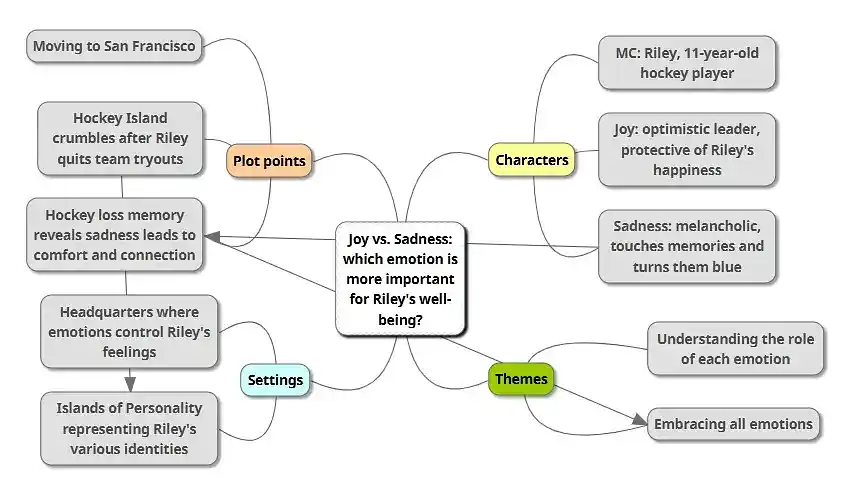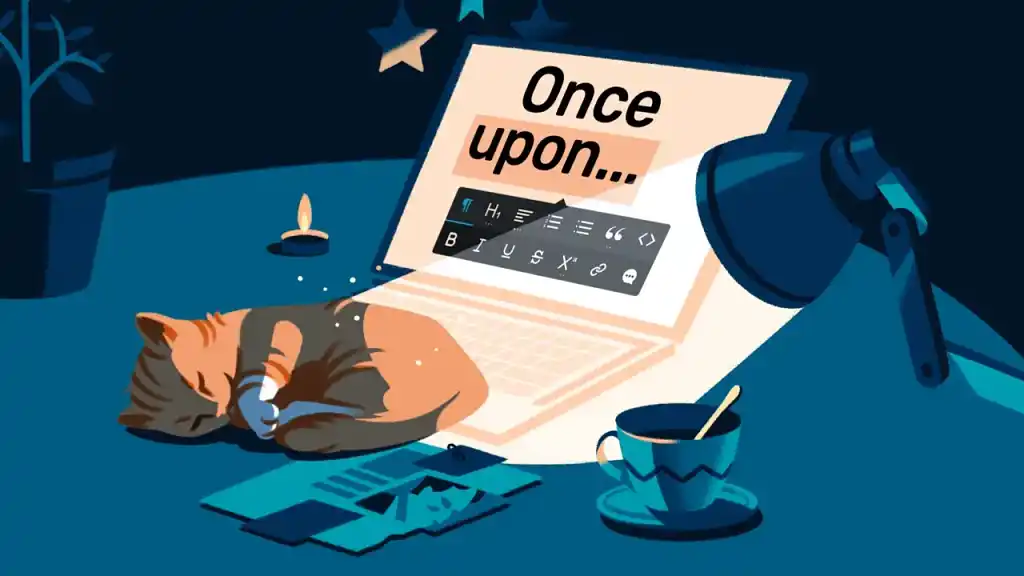Prewriting is the initial stage of the writing process that takes place before you draft your manuscript. Its primary purpose is to help writers generate, explore, and refine story ideas through methods like brainstorming and outlining. In other words, it helps you clarify your vision and lay a solid foundation for your manuscript.
Whether you're writing a novel, short story, or creative nonfiction piece, thoughtful prewriting can mean the difference between a focused first draft and a meandering one. In this post, I’ll walk you through what prewriting entails, sharing some examples and tips to incorporate it into your own creative process.
1. Develop your story idea with various strategies
The first step is to sketch one or more story ideas. Maybe you have an intriguing character in mind but no storyline, or a powerful character arc without a clear “story middle.” How do you expand on them to assess their story potential?
There are a few strategies you can use. Each provides a unique angle on idea development, and you'll likely need to experiment with several to discover what fits your creative style best. Let’s look at four of the most common ones:
Brainstorming
Brainstorming is perhaps the most straightforward prewriting strategy. Set a timer for 15 to 20 minutes and write down characters, settings, plot points, themes, or any other story elements that come to mind.
For example, say you want to write a young adult novel about a brilliant high school football captain whose relentless drive for perfection pushes him to the edge of self-destruction. You might jot down:
- 🏈 Character: A charismatic star quarterback hiding debilitating anxiety and imposter syndrome
- 🏫 Setting: Elite high school where sports victories define status and scholarship opportunities, amplifying every success (and every failure)
- 🎢 Plot points: Obsessive training routines, social media fixation, secretly experimenting with performance-enhancing drugs, risking genuine relationships to maintain one’s image
- 💭 Themes: The destructive cost of perfectionism, self-worth beyond achievements
- 📚 Potential titles: “Pressure Point,” “Breaking Perfect”
Try to do the same for all your fragmented story ideas without worrying about nailing all the details. The point is to flesh out your story as much as possible.
Mindmapping
If you’re a visual thinker, mindmapping may be your preferred tool for story development. This technique is similar to Brainstorming, but it creates a visual representation of ideas and their relationships, allowing you to see connections that might not be apparent in linear formats.
Start with your central concept in the middle of a blank page, then draw branches for main elements like characters, setting, plot, and themes. From each of these, draw smaller branches for specific details or ideas. Or connect them to each other, if that’s helpful.
Here’s a rough example of a mind map for Pixar’s Inside Out:

You can do this on a piece of paper or by using tools like Mindmup or Canva.
Freewriting
Freewriting involves continuous writing without stopping to edit, judge, or even stay strictly on topic. Ignore the thought that your story idea “would never sell” or that “it has been done so many times already.” The goal is to bypass your internal critic and tap into your subconscious creativity.
Set aside 20 to 30 minutes to write continuously about one (or more) of your story ideas. Start directly from a compelling moment or intriguing plot point, and keep typing no matter what emerges. For example:
Emma finds the box in the attic while looking for Halloween decorations. It's her grandmother's — it has to be — with those faded flowers painted on the lid. Inside are letters, dozens of them, all addressed to someone named "V" who isn't her grandfather. Who is V? And why did Grandma keep these hidden? Emma's mother always said Grandma was perfect, the ideal wife and mother. These letters tell a different story.
Freewriting often produces surprising connections and details you might never discover through more structured approaches. When you finish, try to highlight what elements of this story really spark your interest, then run it through one of the other techniques (like Brainstorming) to sketch it out further.
Query letter writing
Finally, writing a mock query letter is another way for you to articulate the core elements of your story. This approach works best if your story idea is already quite sketched out, and you want to gauge its market potential.
When crafting your query, focus on:
- The hook: what makes your story immediately compelling.
- The synopsis: a summary of the story's core conflict, characters, and stakes.
- The market proof: why there's a market for this story and why you're the right person to write it.
For example:
- Hook: When sixteen-year-old Marcus Chen discovers his perfect GPA and athletic scholarship can't protect him from panic attacks, he turns to underground performance enhancers that promise success at any cost.
- Synopsis: Marcus's dependency on pills grows just as his team faces championship season and Stanford scouts are watching. When his best friend Zach discovers his secret and threatens to tell their coach, Marcus sabotages Zach's position on the team. As the drugs' side effects worsen and his relationships crumble, Marcus must choose between maintaining his perfect image or admitting his struggles before he loses his health, his future, and everyone who actually cares about him.
- Market Proof: This YA contemporary novel will appeal to fans of sports dramas such as FRIDAY NIGHT LIGHTS, as well as readers of Laurie Halse Anderson, John Green, and other authors who explore mental health themes. As a former high school counselor, I've witnessed firsthand how perfectionism can become destructive among high-achieving teens, especially in the age of social media.
This exercise might be the most difficult one, but it can yield the most clarifying results.
You can run your idea through multiple exercises until you feel confident it’s the one you want to pursue the most. But before you start to refine it, define your why.
2. Identify your motivation and target audience
Once you’ve chosen your winning idea, take a moment to clarify your why. Why are you writing this particular story and who are you writing it for? This clarity will sustain you through the writing process.
The thing is... it's not always apparent to us why we want to write about something. And sometimes we discover that during the writing process. That's perfectly normal! But starting with some reflection can give you a stronger foundation.
Ask yourself these fundamental questions:
💭 What compels me to tell this specific story? It could be to share a personal experience, examine a social issue, or simply to entertain. For example, maybe you want to explore grief through a ghost story, or examine class differences through a contemporary romance.
👥 Who am I writing for? Define the demographics, interests, and overall profile of who might enjoy this story. Think of someone you actually know in real life, and build a reader persona off of them (e.g., for romantasy, readers between the ages of 18 and 30 who enjoy reading about strong heroines, complex magical systems, and tales of forbidden love between mortals and immortals).
🎯 What do I want readers to take away from my story? The emotions, thoughts, or new perspectives you hope to inspire. Do you want them to question something, feel comforted, or be entertained?

The clearer you are about your motivation and audience, the more focused your prewriting becomes. Instead of trying to appeal to everyone (which often results in appealing to no one), you will speak directly to your ideal readers.
Next, you want to cut the chaff from your raw material.
3. Narrow your topic to a manageable scope
Earlier, I kept the prewriting examples brief (and already quite polished) for the sake of clarity — but in reality, these techniques often produce messy and superfluous material too. That’s why the next crucial step is narrowing the story’s scope. Here are some good pointers to focus on the essentials:
⚔️ Identify the primary conflict and 2 to 3 supporting conflicts that enhance it. For example, your main character's struggle with perfectionism might be your primary conflict, while supporting conflicts could include tension with his best friend who discovers his performance-enhancing drug use, pressure from his father who was a former football star, and his growing feelings for someone who sees through his perfect facade.
🎯 Determine the thematic focus. While your story might touch on many themes (e.g., perfectionism, friendship, identity), choose one to emphasize above all (e.g., self-worth beyond achievements).
👥 Focus on a core cast of characters. Your story will be stronger with a few well-developed characters than with a dozen shallow ones. For example, you could focus on the protagonist, his best friend, his love interest, and his coach — leaving the entire defensive line as background characters who don't need individual development.
🗺️ Select the most essential settings. Ask yourself: Which locations create the most interesting conflicts or reveal important character dimensions? For example, the protagonist’s home, his high school, and his training facility.
With a clearer, more concentrated vision of your story, you can now develop a flexible outline that captures its essence while leaving room for discovery during drafting.
4. Create a flexible outline that works for you
An outline should provide structure while honoring your personal writing style. If you're a planner, you might create a detailed chapter-by-chapter breakdown. If you're more of a pantser, your outline might simply identify major plot points.
There are several story structures you can follow, from The 3-Act Structure and Freytag's Pyramid to The Hero's Journey. Pick your favorite! But regardless of which you choose, most stories include these essential elements:
- Exposition: A compelling opening scene that establishes your character in their "before" state
- Inciting Incident: The catalyst moment that launches your story and presents the central problem
- Rising Action: Your character's actions toward solving their problem, plus 3 to 5 escalating obstacles or challenges
- “All Is Lost” Moment: The darkest point when failure seems inevitable
- Climax: The turning point where your character makes a crucial decision or takes a decisive action
- Resolution: How your character finds their way out (which may involve getting what they need, not what they want)
- Denouement: A meaningful closing scene that showcases your character's transformation
Try using sticky notes or index cards for your outline — they make it easy to rearrange scenes as your understanding evolves. Digital tools like Reedsy Studio or even a simple Google Doc can work well too.

Remember, the best outline is one that gets you writing, not one that's perfect. As you draft, you'll discover new connections and possibilities that no amount of pre-planning could have revealed. This brings us to our final point about the prewriting process.
5. Remember that pre-writing is recursive
As you develop your story, remember that creativity is a discovery process. What you uncover while creating an outline might send you back to brainstorming for new character motivations or unexpected plot twists. This cyclical journey is natural and valuable.
Many writers continue aspects of prewriting even as they draft their manuscripts — pausing at chapter three to create a quick mindmap for a new subplot, or revisiting character profiles when a secondary character suddenly demands more depth. These moments of return aren't setbacks 一 they're signs of your story's organic growth and your evolving understanding of your narrative.
Prewriting isn't about following someone else's system perfectly. It's about discovering the preparation methods that’ll help you write with greater purpose, clarity, and confidence. Now, it's time to put these techniques into practice and prepare your next big story.









